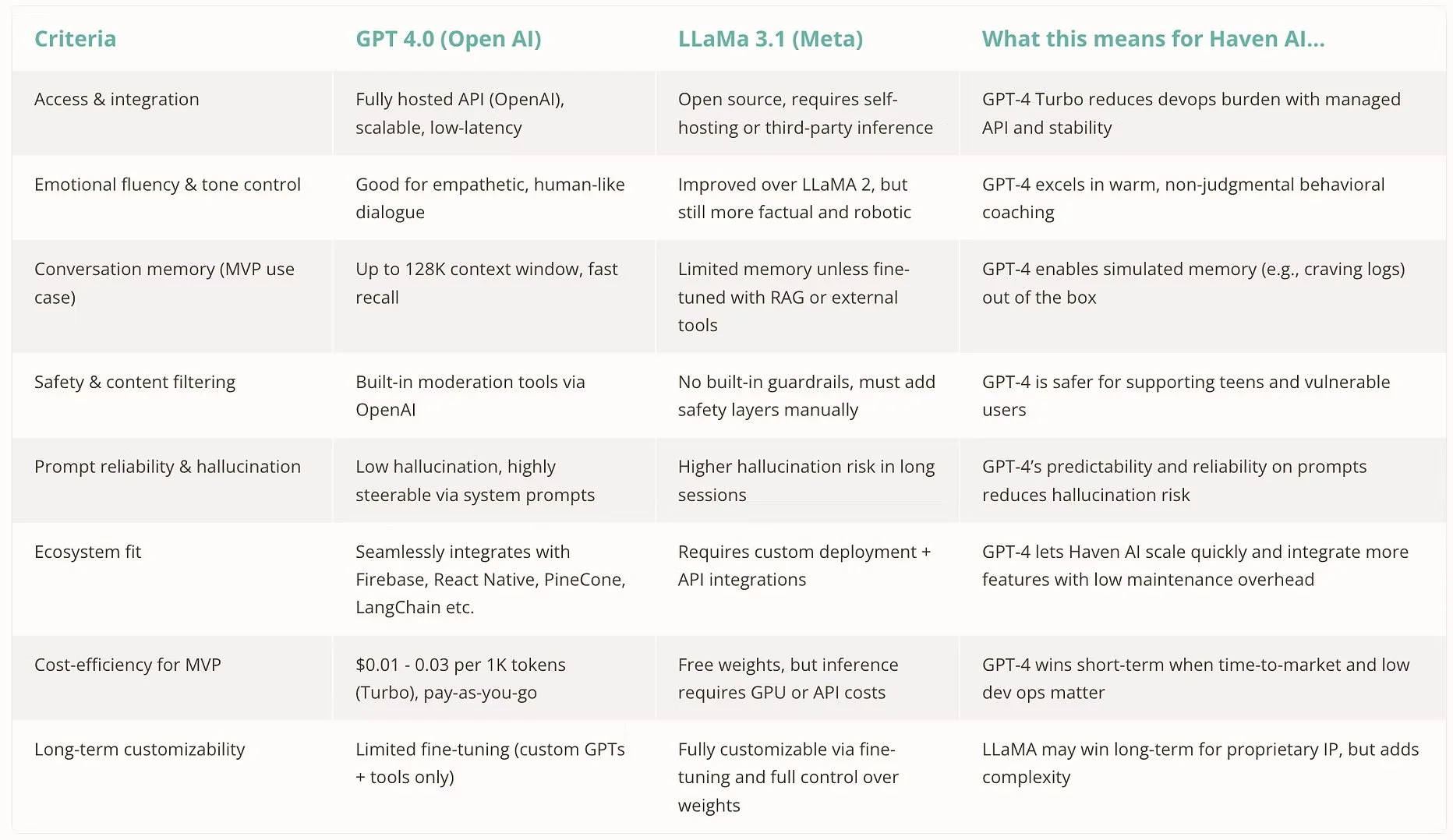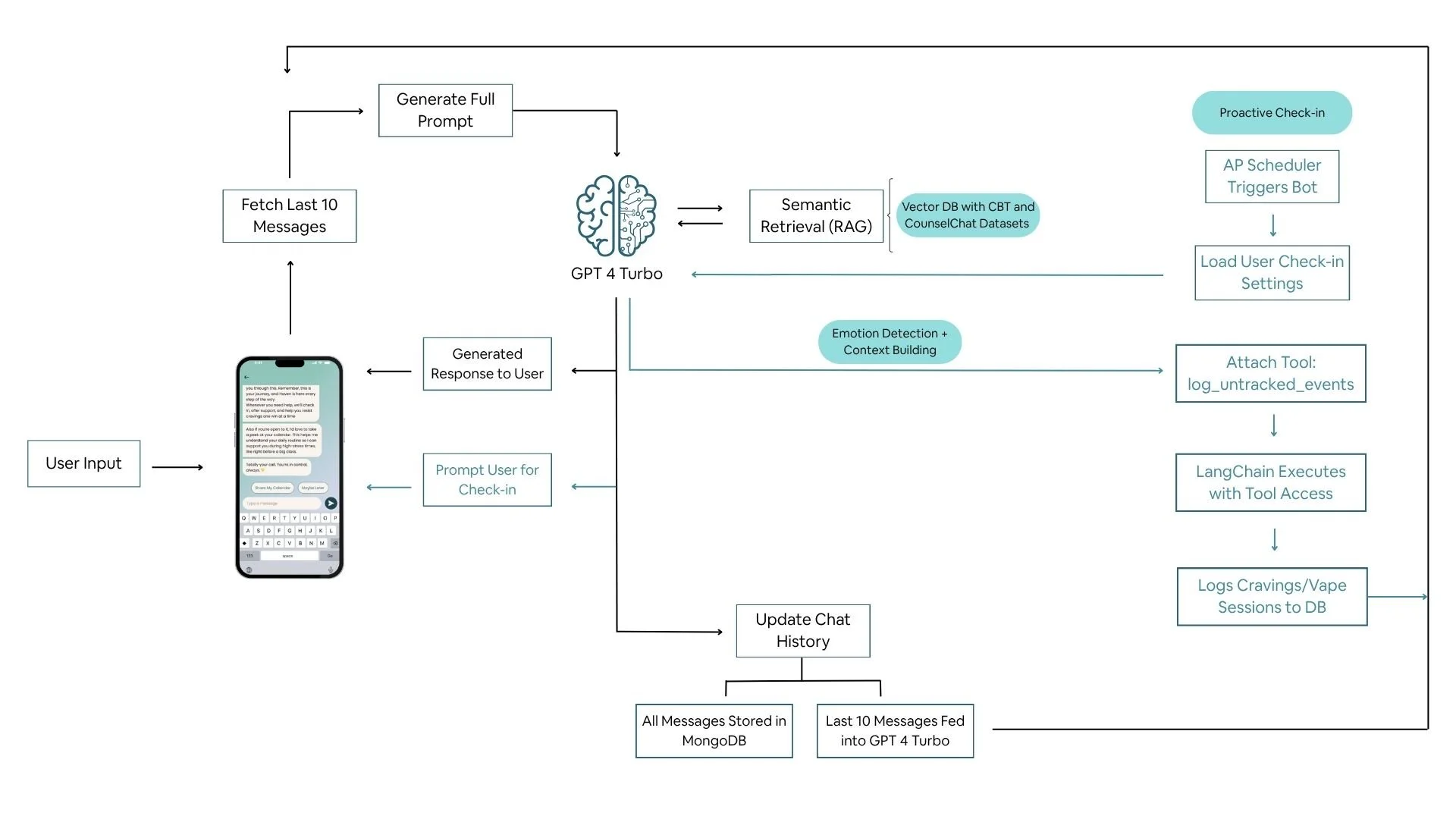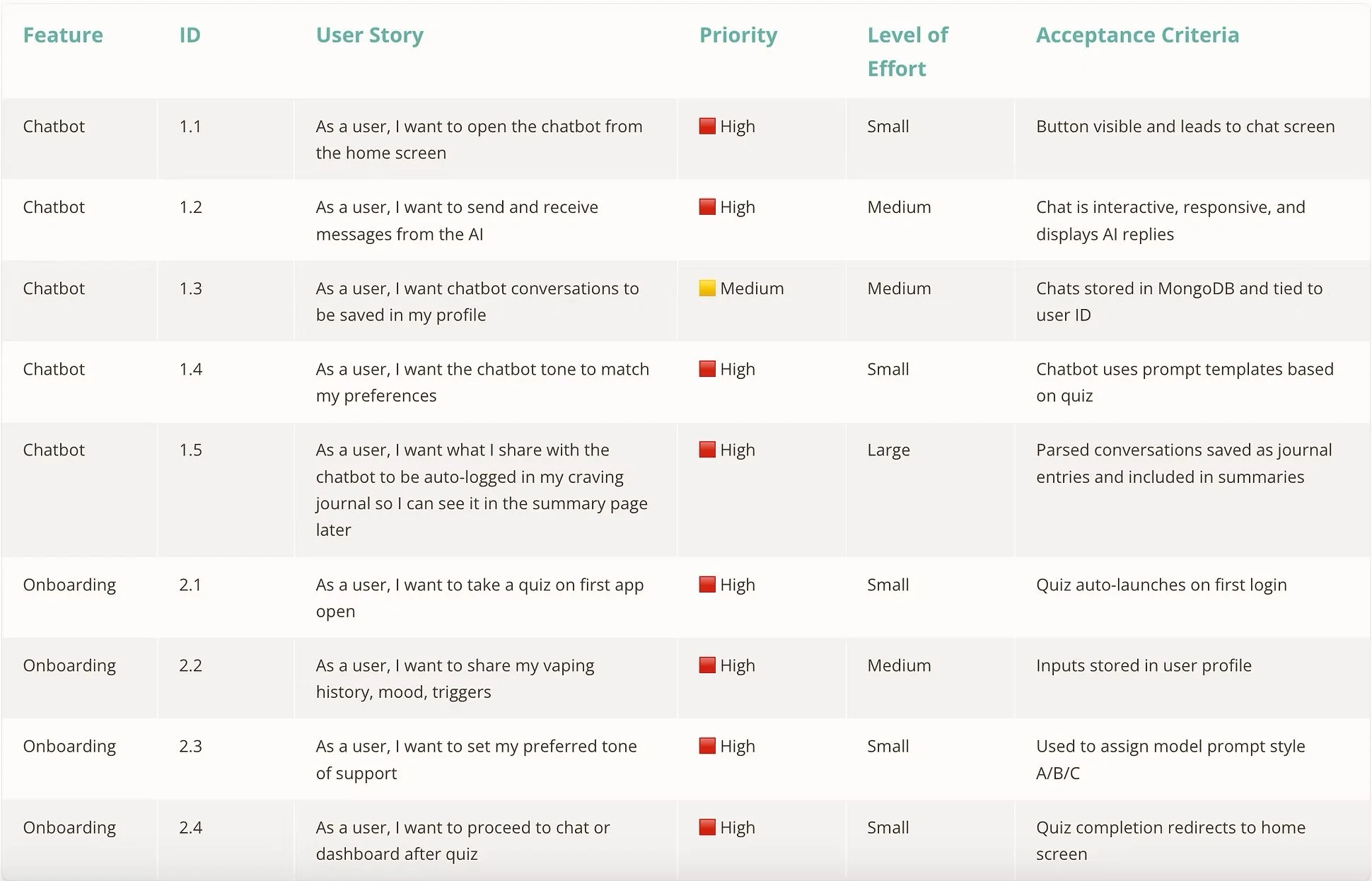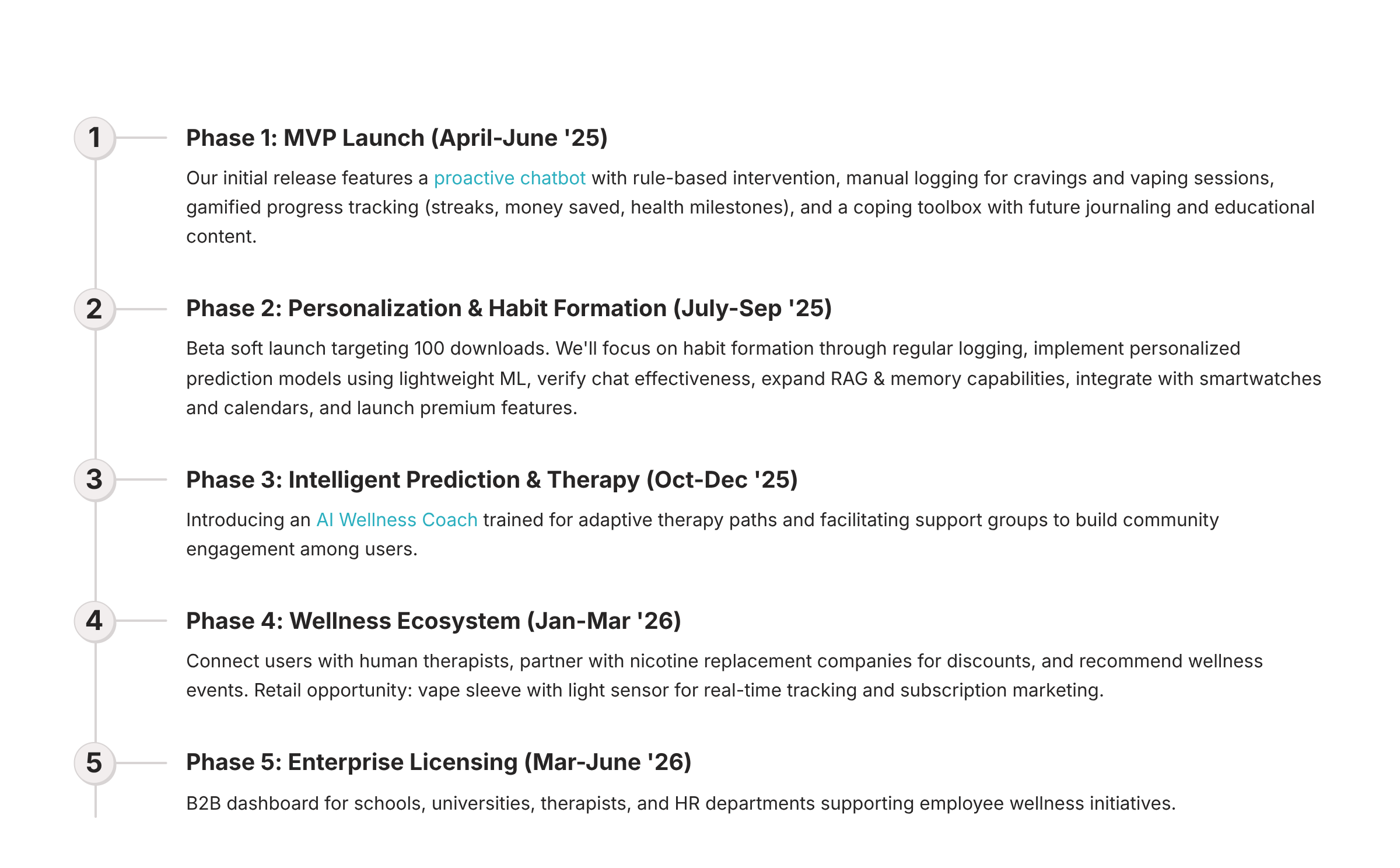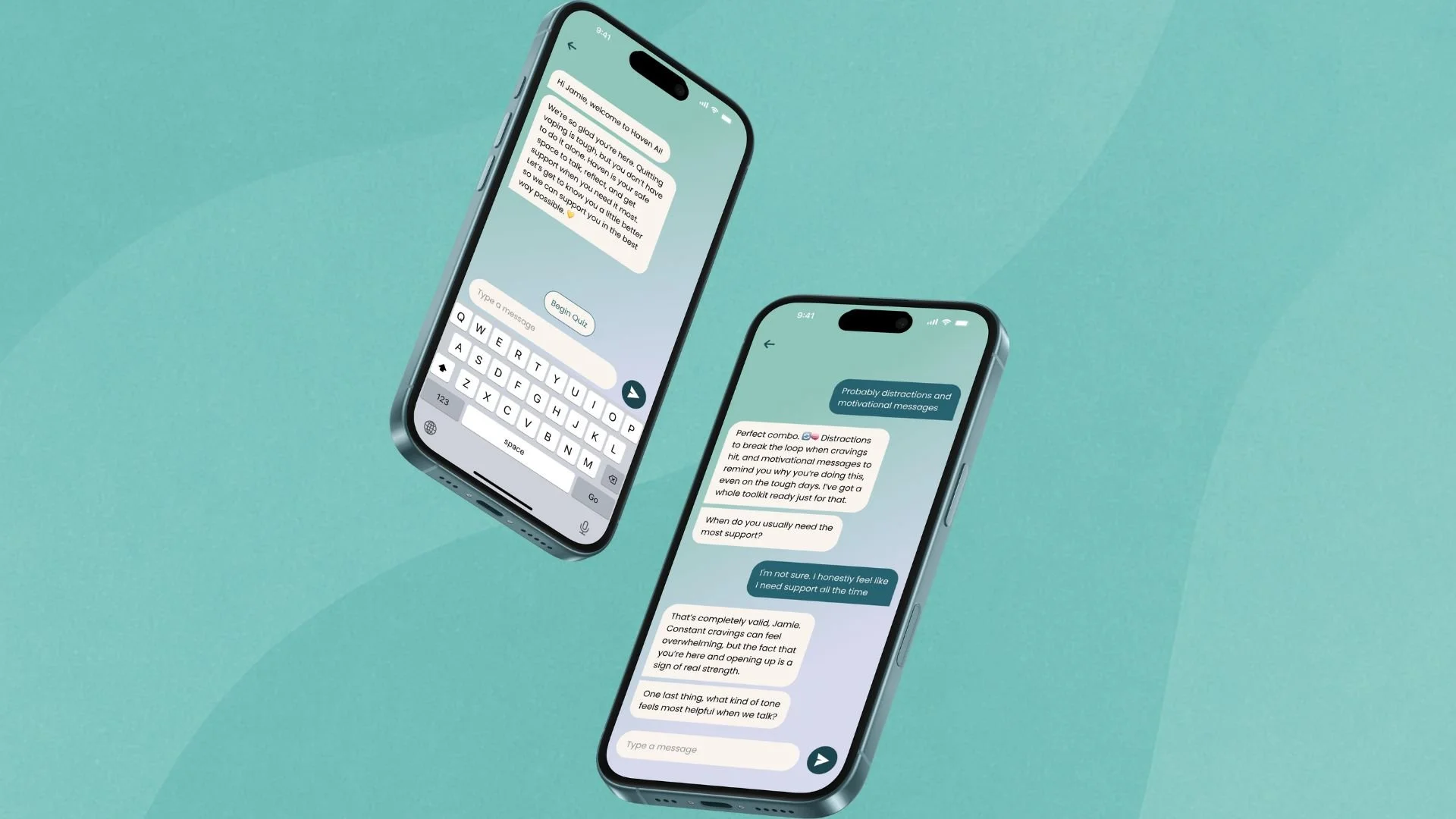
Haven. AI
Haven.AI is a digital wellness tool designed to help users quit vaping through personalized AI support. The MVP integrates a GPT-4-powered chatbot with emotional tone adaptation, a vaping/craving journal, self-help tools (breathing, meditation, reflection), and a progress dashboard tracking milestones and money saved.
Year
2025
Type
B2C/B2B
The Problem
Vape Epidemic
82 million active vapers globally struggle with cravings triggered by stress, routines, social settings, or boredom.
Lack of Support
The growing need of quitting and insufficient supply of professionals and tools make traditional smoke intervention services inaccessible and costly.
Frustration ->Relapse Cycle
Traditional quit vaping apps lack personalization and real-time support, leading to relapse when cravings hit. Users feel defeated and doomed after giving in to cravings, creating a negative cycle that's difficult to break.
OUR SOLUTION
OUR SOLUTION
Haven.AI is a proactive, AI-powered chatbot designed to support users in quitting vaping through personalized interventions and practical self-help tools.
Unlike traditional cessation apps that are passive and one-size-fits-all, Haven.AI anticipates high-risk craving moments and delivers timely, tailored support modeled after therapeutic interactions—helping users stay on track before a relapse occurs.
Haven.AI is also the only solution designed to support both cold-turkey quitters and those choosing a gradual reduction approach, meeting users wherever they are in their journey to quit for good.
AI HYPOTHESIS
If Haven.AI proactively initiates personalized and actionable conversations with users to interrupt the craving cycle—with at least 60% precision—then users will be more likely to resist the urge to vape. This not only improves their quality of life and strengthens their trust in the AI, but also drives higher user retention, positive reviews, referrals, and ultimately, revenue growth.
Feature Highlights
1.Registration & Onboarding Quiz
Empathic, CBT trained chatbot that offers support like a real therapist, adapting to each user’s unique journey based on their profile and real-time emotional state.
Gamify it: earn virtual chips, badges, and milestones by committing to the process.
2. 1 Progress Dashboard (Cold-Turkey Ver.)
After logging vaping events, the user can see their days clear of vaping, money saved, and health score improvement in the dashboard.
2.2 Progress Dashboard (Taping Off Ver.)
Haven.AI is the only solution in the market that caters to users who want to reduce vaping gradually rather than quitting cold-turkey. Instead of days clean, they’ll be shown a trend-line of their daily vape usage.
3. Craving/Vaping Session Logs & Proactive Check-in
Based on user inputs, calendar events, time&location, the bot can learn the user’s craving patterns and offer support before the relapse happens.
4. Self-Help Toolbox
Includes easy breathing exercises, guided meditations, and reflection prompts that users can access anytime they see a craving happening.
User Research Insights
We conducted 18 voice of customer interview with personal users and corporate HR/Wellness professionals. In the 16-question open-ended survey, we investigate their vaping habits, emotional journey, openness to AI powered quitting tools, and willingness to pay.
-
Most vapers either started or continue to vape due to anxiety or stress. The habit has now become automatic.
-
Users expressed a general feeling of being “defeated by the vape” after multiple failed attempts to quit. When the first craving is not managed with care, they fall into the vicious cycle of quit→defeat→vape.
-
Users appreciate the proactive support of an AI chatbot but express concern over excessive notifications, which can feel intrusive. They also value having access to self-guided tools and gamified features that foster a sense of control, agency, and ongoing motivation throughout their quit journey.
AI Model Selection
We chose GPT-4 Turbo as the LLM (over LLaMA 3.1) for Haven AI's chatbot for the following reasons:
Faster Response Time – GPT-4 Turbo delivers quicker outputs, which enhances the overall user experience during live interactions.
Strong Performance – GPT-4 Turbo generates results that are consistent, empathic, and relevant—crucial for our therapeutic use case.
Seamless Integration – GPT-4 Turbo is part of OpenAI's broader developer ecosystem, designed to plug easily into full-stack product workflows. This reduces engineering complexity and enables lean teams to move fast.
AI-Architecture
Contextual Prompting
Haven retrieves the last 10 message pairs to maintain dialogue continuity and constructs the prompt for GPT.Retrieval-Augmented Generation (RAG)
The prompt is enriched using a RAG pipeline that queries a vector database built on CBT and CounselChatdatasets, enhancing therapeutic relevance and emotional intelligence.Response Generation & Storage
GPT generates responses based on the enriched prompt. Full conversation history is stored in MongoDB, while only recent messages inform ongoing interactions.Proactive Engagement (APScheduler)
A scheduled proactive check-in layer uses APScheduler to trigger GPT-based prompts aligned with user preferences, supporting craving tracking and self-reflection.Behavioral Detection (LangChain)
A LangChain agent detects unreported cravings from natural language and logs them, enabling data-informed personalization without disrupting the user flow.
Data Pipeline
-
1. Data Identification
We sourced two datasets from Hugging Face:
1. CBT (Cognitive Behavioral Therapy) dataset – providing therapy-style conversations, useful for modeling structured therapeutic dialogue.
2. Counsel Chat dataset – including real-world counseling Q&A across mental health topics. -
2. Data Processing
Data Cleaning: Removed duplicates, low-quality responses, and irrelevant content.
Standardization: Unified formatting and structure of both datasets for consistency. -
3. AI Model Preprocessing
We combined the two datasets into a unified knowledge base by embedding the preprocessed data using OpenAI’s embedding model to support our Retrieval-Augmented Generation (RAG) setup.
We then indexed the embedded data using Pinecone vector store to enable fast and relevant retrieval during user interaction. -
4. Continuous Feedback
Round 1: Plain GPT-4 Turbo model, no RAG. The responses lacked context and empathy.
Round 2: Introduced RAG with both datasets. Huge improvement in relevance and tone.
Rounds 3-6: Focused on prompt engineering to shape Haven’s voice.
Tech Stack
To power Haven.AI, we built a cross-platform mobile app in React Native that lets users log cravings, chat with the AI, and receive proactive check-ins through a simple, intuitive interface.
Authentication & Security
User accounts are protected with Firebase Authentication, enabling secure Google sign-in and issuing JWTs that are verified by the backend.
Backend & Infrastructure
Our backend, developed in FastAPI and deployed on Render, manages API endpoints, orchestrates GPT-4 interactions, and handles all business logic. User profiles, craving logs, chat history, and behavioral triggers are stored securely in MongoDB Atlas.
Scalability & Modularity
The modular architecture allows us to deliver real-time, adaptive support while ensuring performance and data privacy at scale.
Collaboration & Design
I led a cross-functional team of engineers working in GitHub with a branch-based workflow for feature development and integration testing. The UX/UI was designed in Figma, continuously refined through early user interviews and onboarding feedback sessions.
AI-Architecture
Challenges & Lessons
-
Making the Chatbot Feel Human
Creating an empathetic and supportive chatbot required more than generic AI responses. By combining a CBT-based dataset with CounselChat content in a retrieval-augmented generation (RAG) pipeline, we were able to craft replies that felt more authentic, emotionally intelligent, and humane.
-
Feature Prioritization
With only two frontend engineers, our ambitions exceeded our capacity. We learned to prioritize high-value features, sharpening the product focus to deliver what mattered most for the MVP: chatbot support, craving logs, and progress tracking.
-
Building Conversational Memory
Maintaining meaningful context was essential for trust. We implemented a lightweight memory system that continuously fed the last 10 user-chatbot exchanges into the model. This allowed for more natural, coherent, and personalizedconversations.
-
Seamless Logging
We wanted craving logs to feel effortless. Using an agent–tool framework, the chatbot could detect when a user mentioned a craving and automatically log it in the background, making data capture frictionless and user-friendly.
-
Balancing GPT-4 Power with Performance
Long prompts produced thoughtful, empathetic responses — but slowed down the conversation. Through iterative prompt engineering and testing, we learned to balance empathy, brevity, and speed, ensuring the chatbot could provide real-time support without losing depth.
Product Roadmap

AI Scalability
Haven.AI is designed with long-term scalability at its core, ensuring our chatbot continues to provide effective, personalized support as more behavioral and usage data is collected.
We’ve implemented prompt optimization and real-time context management, allowing the chatbot to adapt dynamically to evolving user behavior. This ensures that Haven.AI stays relevant and reliable, even as patterns of craving, relapse, or motivation shift over time.
To minimize risks of hallucinations and bias, our RAG (Retrieval-Augmented Generation) layer is fine-tuned on diverse mental health and CBT-based datasets. Outputs are continuously monitored for safety, empathy, and unintended responses, reinforcing trust in the system.
This modular, scalable architecture enables Haven.AI to deliver emotionally intelligent, context-aware support that grows more accurate and personalized as the platform learns from user needs—building resilience and impact over time.









